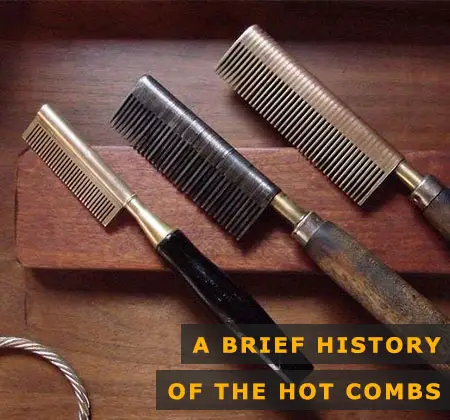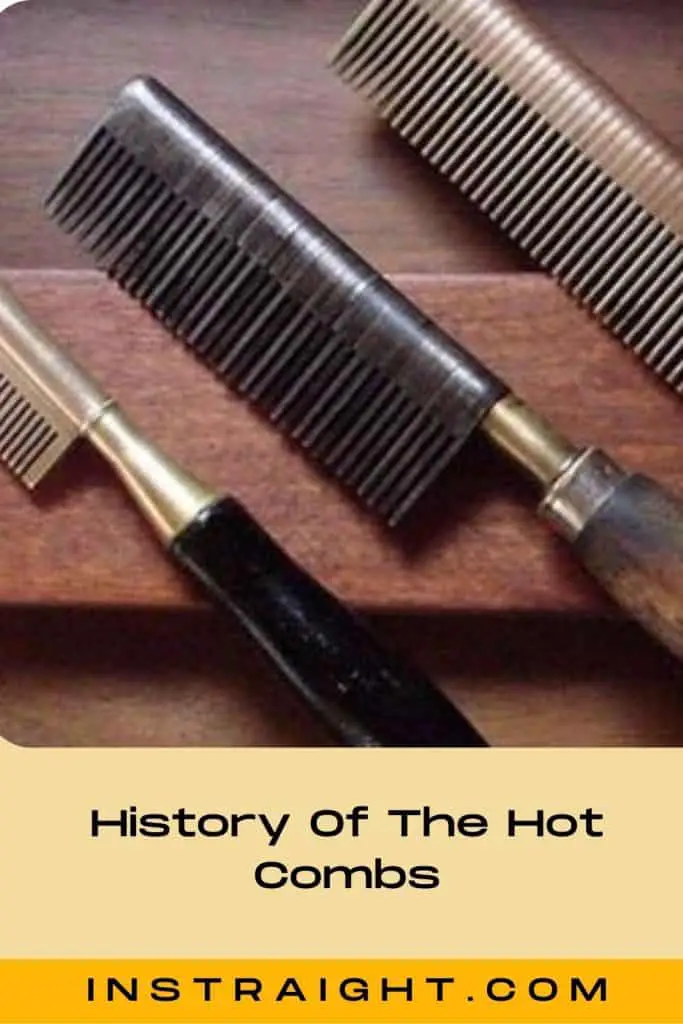Hot combs, a common beauty gear for millions of fashionistas, have been gracing the realms of hairstyling for over centuries.

Also known as singeing combs, the versatile hair tool is used primarily for straightening and smoothing down coarse hair and adding waves to fine hair.
The tool masks a complicated history, which I’m going to put some light on here.
Check: The Best Electric Hot Comb
The History
Although we could consider the device as an anonymous technology, for the tool has evolved with no actual identified inventors or forgotten inventors, we cannot deny the credits of some people who had popularized hot combs.
ALSO CHECK: Best Way to Clean a Comb
Outset
Francois Marcel Grateau [1], a Frenchman, who invented the first hot curling iron back in 1872 (resembled a pair of tongs that used to create marcel waves), was the first to bring forward the idea of implementing heated conductors in hair tools.
After migrating to the USA and changing his name to Woelffle, he had got a patent for it in 1905 before patenting its “electrical version” in 1918.
The electrified edition was more controlled and more capable of producing longer-lasting waves without injuries.
Having got inspired by Woelffle’s work, George Augustus Scott, a US investor, sold the first electric comb in 1880.
The comb was a part of a comprehensive line of beauty products that included curlers, crimpers, and corsets. Even though Scott had marketed it as a beard curler for men, the ladies couldn’t resist using it.
And it resulted in brilliantly later on, after an actress called Lillie Langtry had used it to create her signature loose fluffs.
According to Scott, the products had healing properties besides their ostensibly aesthetic values.
For example, he claimed his electrical hairbrush to be an effective solution for dandruff, neuralgia, and headaches. Back in those days, the purported electrotherapy products were much sought after.
But in reality, Scott’s devices hardly had anything to do with electricity. Neither did they plug into electric power outlets, nor they operated on batteries.
Instead, they ran on embedded magnets, indicating to the “should have been term magnetic.” The small magnets, by no means, produced the magical effects at all despite the emblazons.
The devices of Grateau and Scott, like every other beauty product in the USA at that time, were targeted at white consumers.
The number of hair care products suitable for African Americans was far-limited. Three women sought to alter that with the turn of the twentieth century.
They also went on to build an enormously successful business afterward.
READ MORE: Do Hot Combs Damage Hair?
Evolution
The first of the three was Annie Turbo Malone [2]. She started manufacturing hair-care treatments as early as 1900 under the trademark “Poro.”
With the assistance of a group of saleswomen, she used to sell them door to door in the streets of St. Louis.
In 1917, she established the Poro College, a training institute for educating women about black cosmetology. The institute later expanded to several other cities inside and outside the United States.
Sarah McWilliams Davis, who also lived in St. Louis in a concurrent timeline, learned about Annie Malone’s products.
She joined the Poro as a sales agent in the hope of finding a remedy to both balding and dandruff that she had been suffering from.
The hot combs mostly used to run on a particular gas burner back then, since the electrified version was still underdeveloped and wasn’t friendly enough to apply for an average user.
When Sarah moved to Denver in 1905, she began to develop her own formulas besides continuing to work for the Poro.
She married Charles Joseph a year later and founded her own business under the pseudonym Madam C.J. Walker.
After two years, she had to relocate to Pittsburgh for setting up Leila College, a beauty school. She started making remarkable progress there on developing an advanced edition of electrical hot combs.
Malone came to know about Sarah’s enterprise and began to write cautionary letters while also running newspaper ads. Both of them pursued copyrights for the formulas. Sara kept on competing the Poro College.
Sara Spencer Washington was the third woman to promote African American hair care. She opened a small shop of beauty goods and started marketing her own line of products.
In Atlantic City, Spencer went door to door for selling her goods before founding the Apex News and Hair Company in 1920.
Following the paths of Malone and Sarah Davis, she also set up a training school. By 1938, their number expanded to ten across the USA and South Africa.
The three businesswomen, with their own lines of products and techniques, had actually set up the threshold for the next generation of African American beauticians.
Where the Madam C.J. Walker method brought a fortune to Sarah Davis throughout the 1940s and 1950s, which introduced a revolutionary electrically operated hot comb, the formulas of the other two fell behind by notable margins in their development.
But they did become millionaires themselves too; hair-puller irons worked out for Poro and curling iron for Apex.
Thus, Madam C.J. Walker started collecting applauds, being credited as the inventor of the modern hot combs, even though she kept disclaiming the credit.
Instead, Sarah Davis, (aka Madam C.J. Walker) called herself the most successful entrepreneur for the mass production of the hair tool.
Related: Comb Over Perm (Say Goodbye to Chemical Hair Perms)
On a Final Note
The history of hot comb entails not just the history of a range of other hot tools, but also the backstory of African American women achieving their financial independence and autonomy through beauty industries.
In an era when most of them struggled to find jobs like cleaning, serving, or washing, employment as beauticians commanded honor and esteem within the communities.
Therefore, the anonymous technology also deserves a revered remembrance having helped them get there.
Sources
1. Who invented the Hot Comb? Inventions and Inventors for kids*** [Internet]. www.who-invented-the.technology. [cited 2022 Feb 3]. Available from: https://www.who-invented-the.technology/hot-comb.htm
2. Brooklyn Legends [Internet]. www.histarch.illinois.edu. Available from: http://www.histarch.illinois.edu/Brooklyn/HSOBI/AnnieMalone.htm

- About the Author
- Latest Posts
Edith is a self-made entrepreneur with a keen business sense that others admire and a total “can-do” attitude. She’s always coming up with new ideas to anticipate her readers’ needs and help solve all their toughest beauty and skincare problems. You can find more about her Here.
FOLLOW HER on Linkedin and FACEBOOK and ThoseGraces Beauty Blog


Wow, wow, wow
I didn’t know that hot combs were invented more than 100 years ago. That’s just amazing. It’s really fascinating to know that women from that era were also fashion forwarded and loved to style their manes with hot styling tools.
Thank you for penning down such an excellent article and walking us through history.
You guys never disappoint.
Keep surprising your readers.
Best of luck.
Dear Rich Luxe,
Thank you very much for taking the time and writing to us. We are overwhelmed by your feedback.
Please keep coming back for more amazing articles.
Hi,
After going through the article carefully, I can conclude that you have described the history of hot combs perfectly. With easy description and the right choice of words, it is extremely reader-friendly and serves the purpose of educating people very well.
I wish you all the best. Good luck.
Dear Maria,
Thank you very much for your kind words. We appreciate our readers’ feedback.
Please keep coming back for more informative articles.
Hello,
I enjoyed reading this article. You included all the necessary information without overcrowding the article.
I love the way your writing.
Keep it up.
Dear Tati,
Thank you very much for loving our articles. We are overwhelmed with your response.
Please keep coming back for more informative articles in the future.